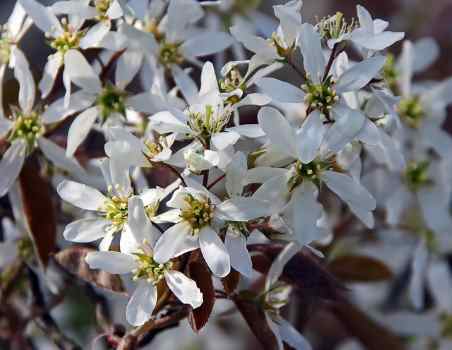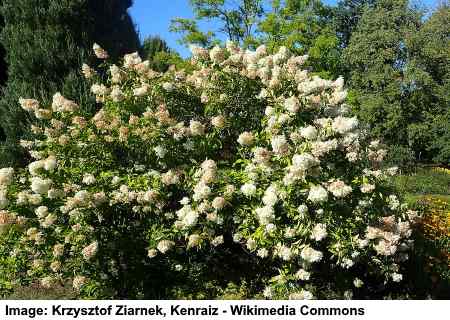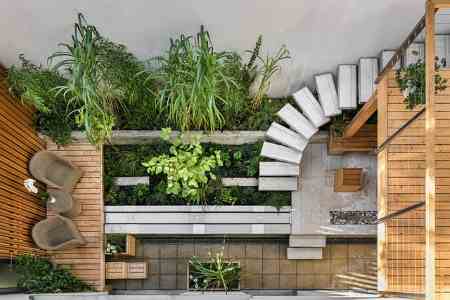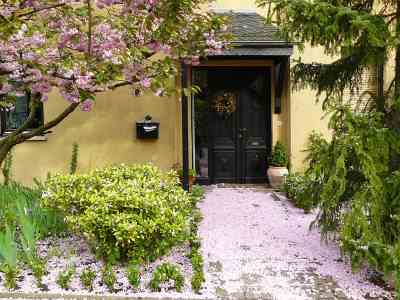35 Small Landscaping Trees (with Pictures): Identification Guide
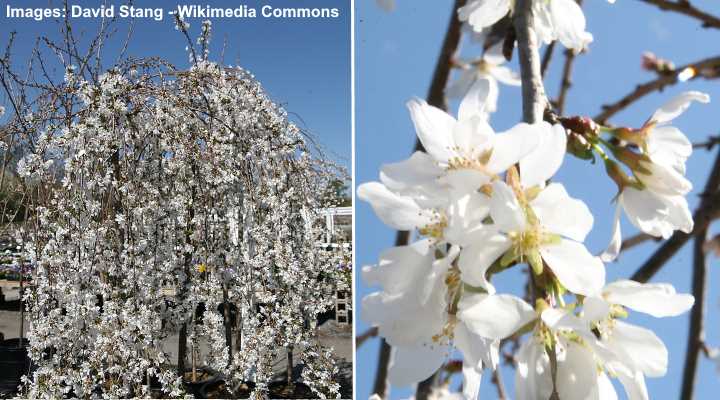
Small trees are ideal for landscaping in small yards where space is limited. Incorporating trees into a small yard offers more than just ornamental value. Many types of small trees provide benefits such as shade, privacy, colorful flowers, wildlife attraction, and abundant fruit. Certain tree species are intentionally cultivated to have a compact size and limited height. Examples of small trees suitable for backyard landscaping include crabapple, red buckeye, gray birch, and cockspur hawthorn.
Some of the best options for landscaping your yard are small evergreen trees that stay under 5 or 6 feet in height. Additionally, there are tree cultivars with dwarf varieties that resemble their larger counterparts but remain a few feet tall. Furthermore, certain small tree species have a spreading growth habit, and you can manage their height through pruning.
This article serves as a guide to selecting the finest small trees for enhancing your backyard, front yard, or even a compact garden.
What is classed as a small tree for landscaping? Generally, any tree that doesn’t grow taller than 20 ft. (6 m) is classed as a small type of tree. Depending on the limited size of your yard, you may have to look for smaller cultivars or dwarf specimens.
How to Choose Small Landscaping Trees
When planning the types of trees for a small landscaped yard, it’s important to consider several factors.
To select the appropriate low-growing tree for your front or backyard, it’s essential to gauge the available space. It’s beneficial to determine the eventual height and spread of the tree. Additionally, ensure that you are aware of the sunlight requirements and whether the small tree thrives in your specific climate zone.
The height of the tree will also dictate its suitable proximity to your house. As a general guideline, the distance between the tree and your home should be at least half of the tree’s height. For instance, if your tree is projected to reach a height of 20 ft. (6 m), plant it at least 10 ft. (3 m) away from the building.
Dwarf Trees vs. Small Trees for Landscaping – Which One is the Best Option?
When it comes to landscaping a small garden, you have a choice between small trees or dwarf trees. Many types of dwarf trees are beautiful ornamental specimens with unique shapes and colors. The advantage of picking out a dwarf tree is that you know what size it grows to. Usually, dwarf cultivars are between 8 and 10 ft. (2.4 – 3 m) tall.
Depending on the size of your yard, you could also look for small miniature trees. Some of these cultivars may only grow to between 6 and 8 ft. (1.8 – 2.4 m) high. Choosing a few miniature trees can add to the aesthetic appeal of your front or backyard.
The Best Small Landscaping Trees (With Pictures)
Here are some of the best small landscaping trees to choose from if your space is restricted. At the end of this list, you will find some varieties of dwarf flowering trees.
Eastern Redbud (Cercis canadensis ‘Ace of Hearts’)
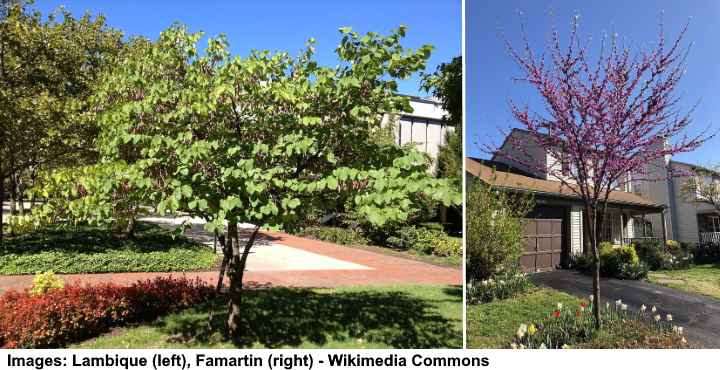
The dwarf eastern redbud cultivar ‘Ace of Hearts’ is an excellent choice for landscaping your front yard. During spring, it adds a vibrant burst of color to the landscape with stunning clusters of small reddish-purple blossoms. Other distinctive features of this small decorative tree include its unique branching habit, dark green leaves that transition into beautiful shades of yellow in the fall, and clusters of pink flowers that bloom in spring.
The dwarf eastern redbud ‘Ace of Hearts’ grows 9 to 12 ft. (2.7 – 3.6 m), making it perfect in size for small yards. It is a beautiful ornamental tree that can be used for accent planting in your front yard.
Mature Size: 9 to 12 ft. (2.7 – 3.6 m) tall and 10 to 15 ft. (3 – 4.5 m) wide
USDA Hardiness Zones: 5 to 9
Sun: Full to partial sun
Weeping Eastern Redbud (Cercis canadensis ‘Lavender Twist’)
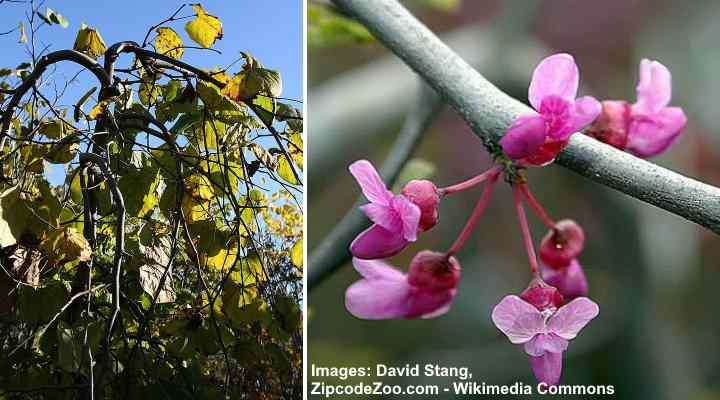
The small, ornamental weeping eastern redbud is perfect for landscaping gardens with limited space. This decorative tree, with its weeping branches, reaches a height of around 6 ft. (1.8 m). It enhances your garden landscape in spring with its attractive, small pink flowers.
The weeping eastern redbud showcases a twisted trunk and branches, adding to its ornamental appeal. This pink-flowering tree blooms in early spring, followed by oval-shaped, dark green leaves that turn yellow in the fall. For optimal growth, plant the tree in well-drained soil.
Mature Size: Around 6 ft. (1.8 m)
USDA Hardiness Zones: 5 to 9
Sun: Full sun to partial shade
Red Buckeye (Aesculus pavia)
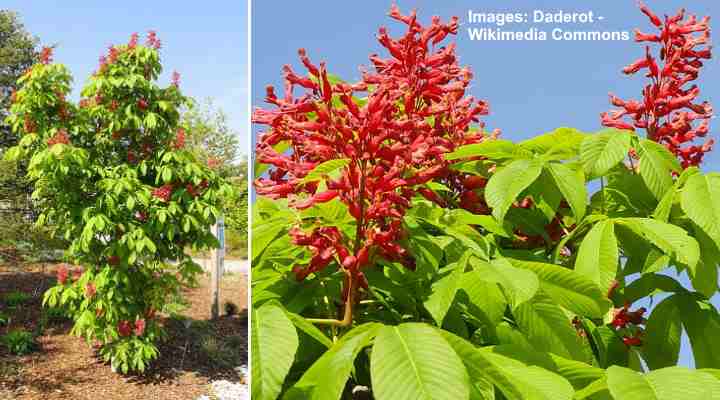
The red buckeye is a low-growing landscaping tree recognized for its beautiful red blooms. It makes a fantastic specimen tree due to its clusters of red, tube-shaped spring flowers that appear at the end of the stems. The flowers are followed by dark brown, shiny seeds that are toxic if ingested.
The red buckeye features pinnately compound, glossy, dark green leaves that add an excellent touch to your garden landscape. With its lush foliage and attractive red flowers, the tree makes a fantastic choice for landscaping a small front yard.
Native to the southeastern U.S., red buckeyes grow best in well-drained, moist soil. In hotter climates, they grow best in partial shade, though they can also tolerate full sun if they receive enough moisture.
Mature Size: 12 to 15 ft. (3.6 – 4.5 m) tall and wide
USDA Hardiness Zones: 5 to 9
Sun: Partial shade to full sun
Small Witch Hazel Trees (Hamamelis)
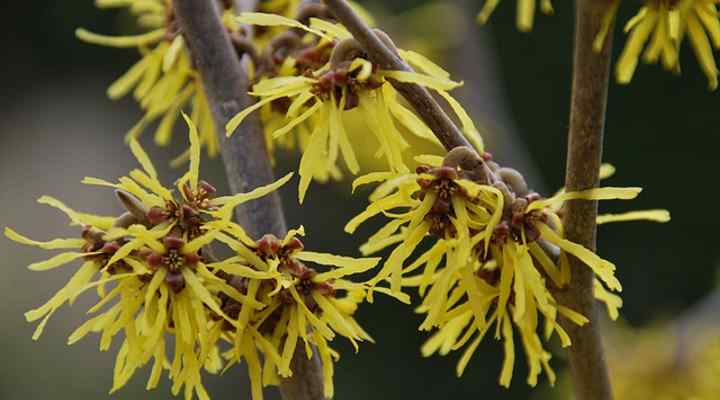
The witch hazel is the ultimate small landscaping tree due to its stunning yellow flowers with distinctive, ribbon-like petals. This yellow-flowering tree has bright green, oval-shaped leaves that turn into lovely shades of yellow-orange during autumn, adding to its ornamental appeal.
The witch hazel can withstand temperatures down to -20°F (-29°C), making it an excellent tree for landscaping gardens in cold climates. Plant this tree in well-drained soil that is rich in organic material. Some landscaping ideas include growing the tree as a privacy hedge, specimen plant, or shrub border component.
Mature Size: Up to 20 ft. (6 m)
USDA Hardiness Zones: 3 to 9
Sun: Full sun to partial shade
Weeping Cherry (Prunus ‘Snow Fountain’)

One of the best small weeping landscape trees for a small yard or garden is the weeping cherry. This small, almost dwarf-sized tree grows to a height of 8 to 15 ft. (2.4 m – 4.5 m). It stands out as a top choice for small landscaping trees due to its slow growth, graceful weeping branches, and low height.
The weeping cherry blossom is a popular tree for small front yard landscaping due to its explosion of stunning small white spring flowers. These snow-white flowers rest beautifully on cascading branches. During summer, the dark green, ovate-shaped leaves provide lush foliage before transforming into shades of orange and yellow in the fall.
Dwarf weeping cherry trees can be used as stunning landscape trees in the center of a front or backyard. They require full sun to grow and thrive in USDA zones 5 – 8.
Mature Size: 8 to 15 ft. (2.4 m – 4.5 m)
USDA Hardiness Zones: 5 to 8
Sun: Full sun
Saucer Magnolia (Magnolia × soulangeana)
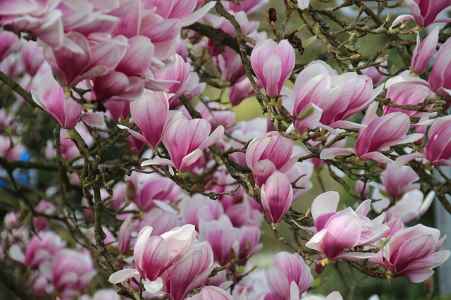
The saucer mangolia is an elegant ornamental tree with beautiful purple, white, and pink flowers in spring. A great choice for front of house landscaping, the tree’s sizable flowers are usually goblet-shaped, two-toned, and emit a captivating scent. It also has glossy, deep-green leaves that turn into spectacular colors of yellow-brown in the fall before dropping.
With its delightful lush foliage and beautiful flowers, the saucer magnolia is perfect for planting as a decorative focal point in your landscape. For optimal growing, plant in well-draining, moist soil in full to partial sunlight.
Mature Size: 15 to 20 ft. (4.5 – 6 m)
USDA Hardiness Zones: 5 to 9
Sun: Full to partial sun
Sargent Crabapple (Malus sargentii)
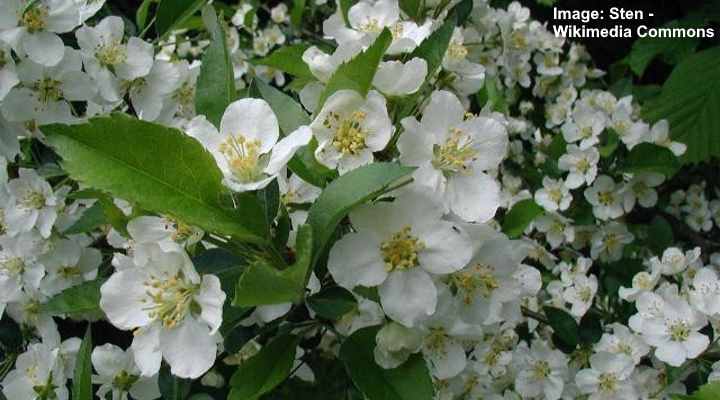
The compact sargent crabapple is a popular tree for landscaping your yard due to its abundant clusters of fragrant white flowers. It produces pea-sized, red fruits that are similar in appearance to berries and are often eaten by birds. The tree has oval-shaped, dark-green leaves that turn into beautiful shades of yellow in autumn.
The sargent crabapple is great for landscaping as a shade tree due to its wide, spreading canopy and dense foliage. For optimal growth, plant in well-draining, acidic, moist soils. You can plant the tree as a privacy hedge, specimen plant, or focal point in your garden.
Mature Size: 6 to 10 ft. (1.8 – 3 m)
USDA Hardiness Zones: 5 to 9
Sun: Full sun
Small Flowering Landscaping Trees (With Pictures)
If your yard is limited in space, then choosing from some dwarf variety of flowering trees can add impact to a small garden without sacrificing space. Many flowering dwarf trees also grow in containers if you want them on your porch or balcony.
Dwarf Pear Trees (Pyrus communis)

The dwarf pear tree, with its decorative flowers and fruits, is sure to enhance the appearance of a small back or front yard
Dwarf pear trees are perfect for landscaping in limited spaces due to their small height of 8 to 10 ft. (2 – 3 m). Pear trees also produce beautiful spring-blooming white flowers, adding a touch of beauty to the landscape. Other ornamental features include shiny, elliptic green leaves, and full-sized, delicious pears.
Dwarf pear trees are great for enhancing your autumn landscape, as during fall the leaves transition into wonderful hues of orange, red, and yellow. Pear trees love moist, well-draining, fertile soils that are rich in organic material. Whether you choose to plant them as attractive specimens or integrate them into a shrub border, dwarf pear trees are sure to add a touch of elegance and beauty to your landscape.
Mature Size: 8 to 10 ft. (2 – 3 m)
USDA Hardiness Zones: 4 to 9
Sun: Full sun
Laceleaf Japanese Maple (Acer palmatum ‘Red Dragon’)
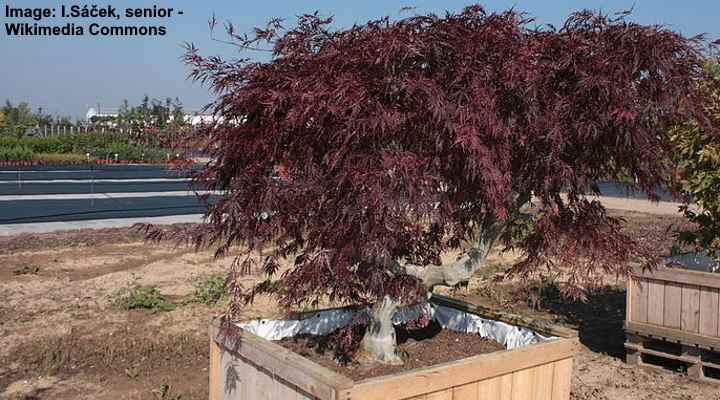
Laceleaf Japanese Maple
With its stunning purple-red foliage, the laceleaf Japanese maple is a fantastic small tree for front of house landscaping. The tree is known for its slow growth and cascading, spreading branching habit. Reaching only around 6 ft. (1.8 m) tall, it’s a perfect tree for planting in small yards. It showcases ferny leaves that resemble the claws of a dragon, giving it its name.
Plant the laceleaf Japanese maple in moist, well-drained soil in full sun for optimal growth. This tree makes a great accent plant, foundation plant, and even an excellent focal point. It can also be grown as a specimen plant in containers.
Mature Size: Around 6 ft. (1.8 m)
USDA Hardiness Zones: 5 to 8
Sun: Full sun
Amelanchier ‘La Paloma’ (Serviceberry)
An excellent landscaping tree, the serviceberry offers masses of fragrant, ornamental white flowers in spring. It has oval-shaped leaves that turn into vibrant colors of orange-red in autumn, contrasting beautifully against the flowers. Additionally, in summer the tree produces clusters of edible red-black berries that are often eaten by birds.
Reaching only around 8 ft. (2.4 m) tall, the serviceberry is an excellent tree for planting near flower beds or for landscaping small yards. It has an open branching habit and light gray bark with gray stripes, adding a decorative touch to the tree’s appearance.
Mature Size: Around 8 ft. (2.4 m)
USDA Hardiness Zones: 4 to 8
Sun: Full sun
Hydrangea ‘Grandiflora’ (Small Tree)
Although generally thought of as a landscaping shrub, hydrangeas can also be classed as a dwarf flowering tree. The beauty of hydrangeas in a small landscape is their huge showy flower heads. The ‘Grandiflora’ grows like a multi-trunk small tree with a multitude of blooms all through the summer.
Hydrangea landscaping trees grow around 10 to 25 ft. tall (3 – 7.5 m)
Discover the most beautiful small flowering trees (with pictures).
Fringe Tree (Chionanthus virginicus)

If you’re looking for an attractive landscaping tree for your yard, consider the fringe tree. It is recognized for its eye-catching, fragrant white flowers that bloom in spring. The flowers have a distinctive, fringe-like appearance due to their wiry petals, adding an ornamental touch. The tree also has elliptic, dark green, deciduous leaves that turn into beautiful shades of yellow in autumn.
Another decorative feature of the fringe tree is when its petals drop to the ground, creating a stunning snow-like covering under the tree. This tree doesn’t tolerate drought and performs best in moist, well-drained soil. Some landscaping ideas include planting as a small shade tree, accent plant, or specimen plant. With its beautiful features and small size, it is perfect for landscaping in small- to medium-sized gardens.
Mature Size: 12 to 20 ft. (3.6 – 6 m) tall and wide
USDA Hardiness Zones: 3 to 9
Sun: Full sun
Small Crape Myrtle Tree (Lagerstroemia)
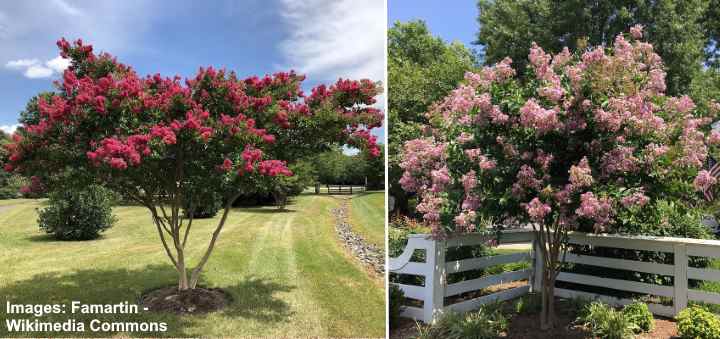
Small crape myrtles are great landscaping trees due to their small size and stunning clusters of showy pink, red, white, or purple flowers. The flowers have a unique, crinkly appearance and grow in abundant conical clusters. The beautiful multi-colored flowers contrast beautifully against the glossy, dark-green, leathery leaves.
Small crape myrtles prefer slightly acidic, well-drained, moist soils. They also have a lovely spreading canopy, with some varieties also reblooming in late summer. Some great varieties include Acoma Crape Myrtle (Lagerstroemia indica × fauriei ‘Acoma’) and Tonto Crape Myrtle (Lagerstroemia indica × fauriei ‘Tonto’).
Mature Size: 5 to 12 ft. (1.5 – 3.6 m)
USDA Hardiness Zones: 7 to 10
Sun: Full sun
Fernleaf Full Moon Maple Tree (Acer japonicum ‘Aconitifolium’)
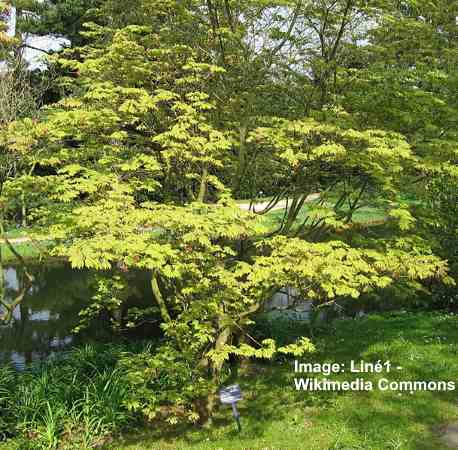
Grow the fernleaf full moon maple as a landscaping tree because of its small size and attractive, feather-like foliage. The leaves turn stunning shades of bright red and scarlet in the fall, adding beauty to the autumn landscape. In spring, it grows tiny red flowers, which then give way to winged maple seeds. The tree has a densely-branched, compact, upright growth habit.
The fernleaf full moon maple is low-maintenance, and ideal for planting in small gardens, tight spaces, or patios. Additionally, it makes a great accent tree, specimen tree, or focal point. To ensure the best growth, plant in moist, organically rich, well-drained soil in full sun to partial shade.
Mature Size: 8 to 10 ft. (2.4 – 3 m)
USDA Hardiness Zones: 5 to 7
Sun: Full sun to partial shade
Purple Leaf Sand Cherry (Prunus × cistena)
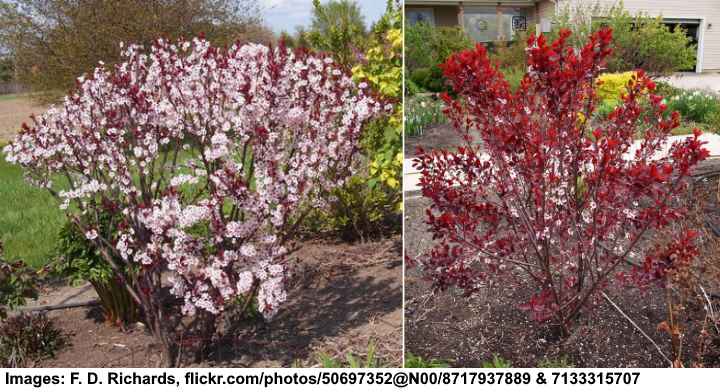
The purple leaf sand cherry tree is sure to add a pop of vibrant color to your garden. Perfect for adding an ornamental touch to your yard, this decorative tree features deep purple-red leaves, sweet-smelling pink flowers, and attractive autumn colors. Growing 6 to 10 ft. (1.8 – 3 m) tall and wide, it makes a great foundation tree in the front of house.
The purple leaf sand cherry is perfect for planting as a decorative shrub, colorful hedge, specimen plant, or in mass plantings. Its stunning pink flowers make it a great option for planting as a focal point. Make sure to plant this tree in well-drained soil to ensure optimal growth.
Mature Size: 6 to 10 ft. (1.8 – 3 m)
USDA Hardiness Zones: 2 to 8
Sun: Full sun
Small Weeping Mulberry (Morus alba ‘Chaparral’)
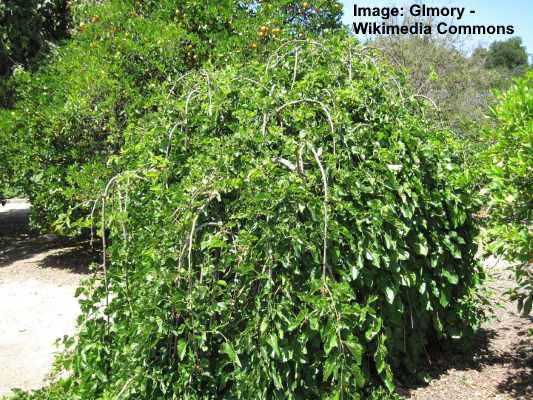
The weeping mulberry is a great small tree for landscaping backyards with little space. It is characterized by its decorative weeping habit and rounded, deciduous, glossy green leaves. Other ornamental features include clusters of yellowish-green flowers and edible blackberry-like fruits.
The small weeping mulberry tree grows in moist, rich, well-draining soil in full sun. Its dwarf height of 6 to 8 ft. (1.8 – 2.4 m) means it’s a great tree for flower beds as well as for landscaping lawns and front yards.
Mature Size: 6 to 8 ft. (1.8 – 2.4 m) tall and wide
USDA Hardiness Zones: 5 to 9
Sun: Full sun
Pygmy Date Palm (Phoenix roebelenii)
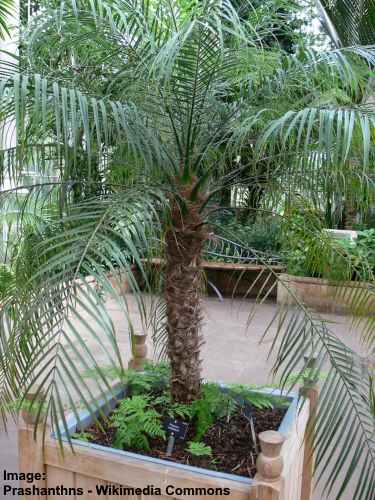
The pygmy date palm is a great landscaping tree for adding a tropical touch to gardens. This compact, subtropical palm tree has attractive, feathery, arching fronds that reach about 3 ft. (1 m) in length. It also produces creamy-yellow flowers and red-black edible fruits that ripen in late autumn.
The pygmy date palm grows best in well-drained, moist soils and is hardy down to 26°F (-3°C). Its small size makes it a great addition to compact garden spaces. It’s also perfect for planting in containers, making it a fantastic choice for patios and courtyards.
Mature Size: 6 to 10 ft. (1.8 – 3 m)
USDA Hardiness Zones: 9 to 11
Sun: Full sun to partial shade
Small Ornamental Frangipani Tree (Plumeria)
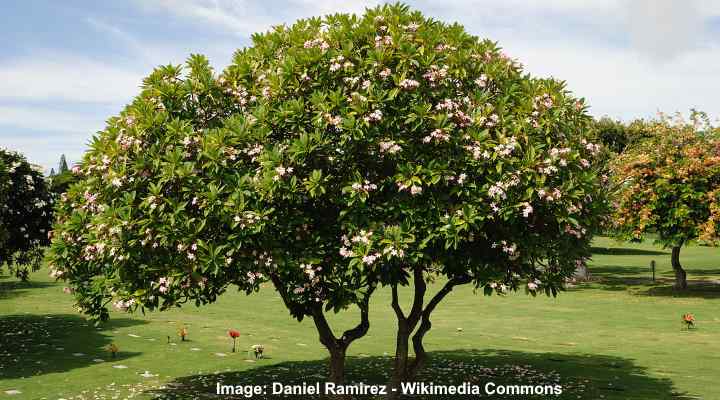
The small ornamental frangipani is a great choice for landscaping because of its decorative flowers. Smaller frangipani varieties typically grow to a height of 6 to 8 feet (1.8 – 2.4 m), making them ideal small trees for planting in the backyard.
However, larger frangipani varieties can reach heights of 20 to 30 feet (6 to 9 meters) or even more under optimal conditions. Therefore, it’s important to select a variety that maintains a smaller size.
The frangipani tree is known for its exotic, white, yellow, orange, or pink blooms. The flowers resemble a star or a pinwheel in shape. It features leathery, oblong, lance-shaped leaves.
Small frangipani trees serve as excellent landscaping additions for tropical or subtropical gardens. Their fragrant flowers are known to attract a variety of pollinators, including hummingbirds and bees. Furthermore, these trees are low-maintenance and display impressive resilience to drought and heat once they’ve become established.
Mature Size: 10 to 20 ft. (3 – 6 m) tall and wide
USDA Hardiness Zones: 10 to 11
Sun: Full sun
Sky Pencil Holly (Ilex crenata ‘Sky Pencil’)
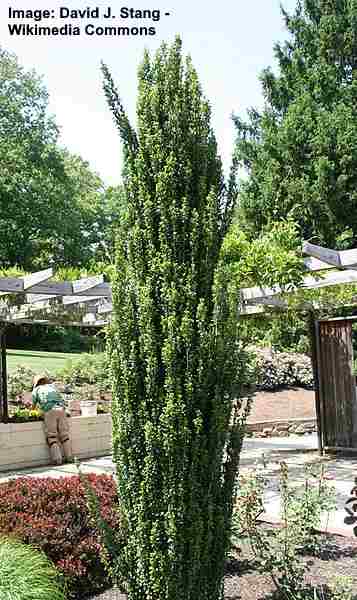
The sky pencil holly is a fantastic, columnar landscaping tree for adding a touch of ornamental beauty to your front garden. With its thin, pencil-like growth habit, it also makes a great addition to tight spaces. The tree has densely packed, glossy, dark green foliage. It produces small white flowers and black fruits.
The sky pencil holly makes a great narrow privacy hedge or screen. This tree is an excellent foundation plant, corner-of-the-house tree, or vertical accent tree. It is adaptable to a wide variety of soil types, as long as they are well-drained. As an evergreen tree, it provides season-round beauty to your garden landscape.
Mature Size: 6 to 10 ft. (1.8 – 3 m) tall and 3 ft. (1 m) wide
USDA Hardiness Zones: 6 to 8
Sun: Full sun to partial shade
Summer Chocolate Mimosa Tree (Albizia julibrissin ‘Summer Chocolate’)
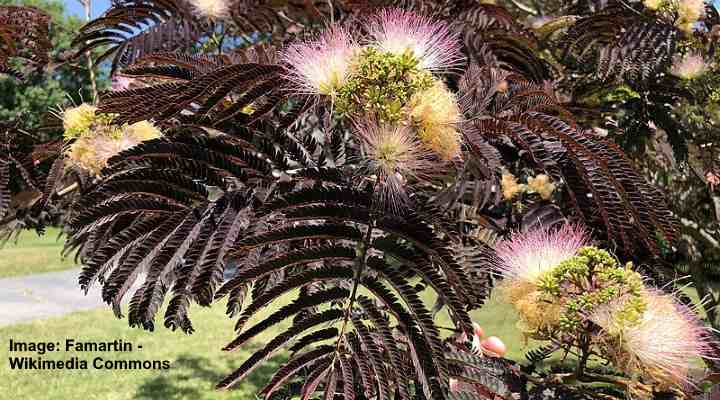
The ‘Summer Chocolate’ mimosa tree is an excellent decorative tree known for its fern-like, deep burgundy leaves. It has fluffy, pink or white flowers that beautifully contrast against the dark foliage. The fragrant flowers attract pollinators such as bees and butterflies, making it an excellent choice for wildlife gardens. The tree also showcases elongated, flat, bean-like seed pods.
The ‘Summer Chocolate’ mimosa tree grows best in full sun in well-drained soil. Its spreading canopy and lush foliage makes it a great option for planting as a shade tree. Other landscaping ideas include planting it as a specimen plant, accent tree, or individual focal point.
Mature Size: 15 to 20 ft. (4.5 – 6 m) tall and wide
USDA Hardiness Zones: 6 to 9
Sun: Full sun
Small Ornamental Chaste Tree (Vitex agnus-castus)
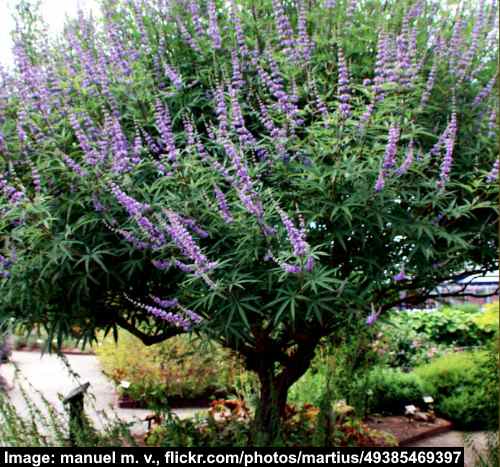
Great for small yard landscaping, the chaste tree is known for its ornamental spires of fragrant purple or blue-violet, summer-blooming flowers. Some decorative features of this tree include aromatic, palmate, gray-green leaves and rounded, red fruits. In addition, it has an upright, dense growth habit.
The chaste tree thrives in well-drained soils. It can be planted as an ornamental focal point, accent tree, or specimen plant. Its small size of 8 to 10 ft. (1.8 – 3 m) makes it an excellent option for landscaping small yards or compact spaces. It is drought- and salt-tolerant once established.
Mature Size: 8 to 10 ft. (1.8 – 3 m)
USDA Hardiness Zones: 7 to 9
Sun: Full sun
Japanese Flowering Quince (Chaenomeles Japonica)
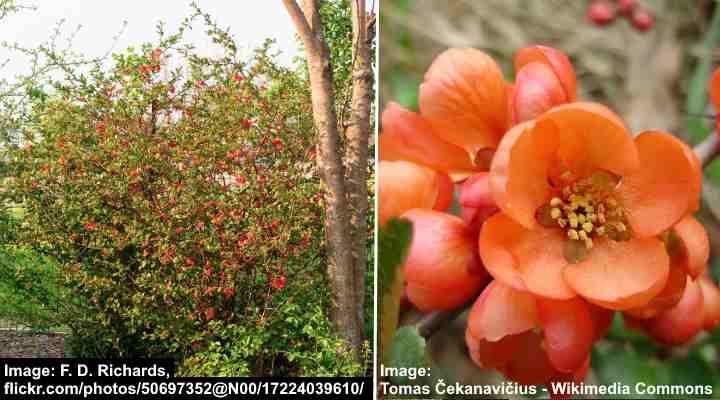
Great for front yard landscaping, the Japanese flowering quince is sure to add a pop of color with its orange, cup-shaped flowers with creamy yellow stamens. Its upright, rounded canopy adds to its decorative appeal. After the flowering period, the tree produces small, golden-yellow to light-green, apple-like fruits.
The Japanese flowering quince grows best in well-drained soil. As an incredibly versatile tree, it can be used as a low-flowering hedge, an appealing shrub border plant, or a striking specimen plant. Its thorn-covered branches also make it a great choice for planting as a security screen around your garden.
Mature Size: 2 to 3 ft. (0.6 – 1 m) tall and 3 to 6 ft. (1 – 1.8 m) wide
USDA Hardiness Zones: 5 to 9
Sun: Full sun to partial sun
Chinese Plum Tree (Prunus glandulosa)
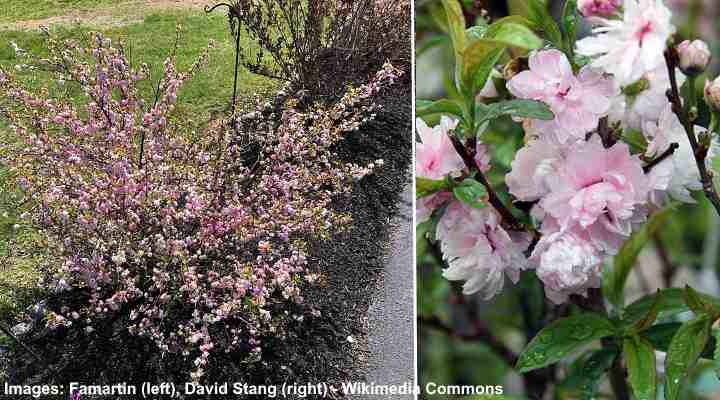
The Chinese plum tree is excellent for landscaping your front yard. It boasts captivating clusters of fragrant, pinkish-white spring-blooming flowers. This beautiful tree has pointy, oval-shaped, glossy green leaves that create a stunning contrast against the pink flowers. Additionally, it produces round, dark red fruits.
The Chinese plum tree grows best in moist, organically rich, well-draining soil. With its spiky growth habit and attractive pink flowers, it makes a great individual focal point in small landscapes. It can also be grown as an elegant accent plant, specimen tree, or corner-of-house plant.
Mature Size: 4 to 5 ft. (1.2 – 1.5 m) tall and wide
USDA Hardiness Zones: 4 to 8
Sun: Full sun to partial shade
Yellow Oleander (Cascabela thevetia)
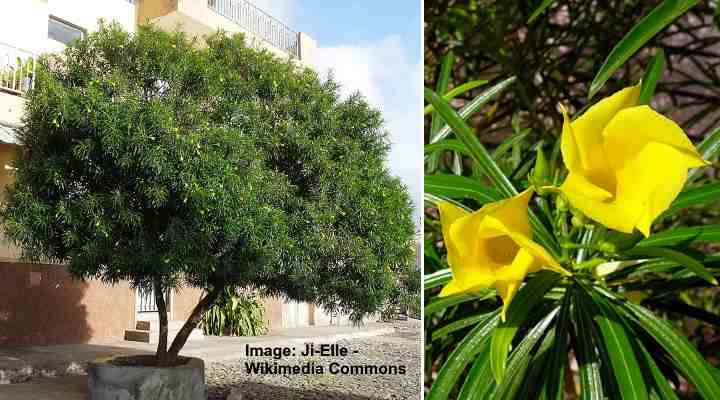
An excellent backyard landscaping tree, the hardy yellow oleander is known for its yellow, tubular flowers. It showcases long, shiny green leaves that contrast beautifully against the yellow flowers. After the blooming period, the tree produces distinctive, rounded green seed pods that transition into a red-black color when ripe.
The yellow oleander is a small, evergreen tree, that thrives in moist, well-drained soil in full sun to partial shade. This attractive tree is excellent for adding an ornamental touch to any landscape. Its small size makes it great for planting in compact spaces. Although it is important to note that all parts of the tree are toxic, so avoid planting it in places where children or pets might be around.
Mature Size: Up to 8 ft. (2.4 m) tall and 4 ft. (1.2 m) wide
USDA Hardiness Zones: 8 to 10
Sun: Full sun to partial shade
Weeping Scotch Laburnum (Laburnum alpinum ‘Pendulum’)
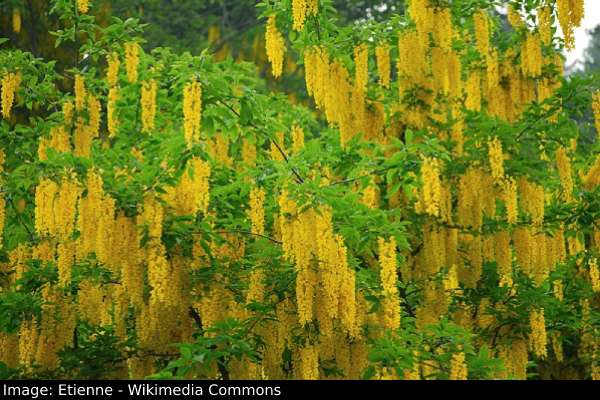
The weeping scotch laburnum is a stunning ornamental tree ideal for small yard landscaping. This tree is characterized by its hanging clusters of fragrant yellow flowers. It features deep-green, glossy leaves divided into 3 leaflets and cascading branches that form an umbrella-like, rounded canopy shape.
The weeping scotch laburnum is suitable for planting in moist, well-draining soil. Its stunning flowers and distinct weeping habit make it a great choice for planting as an individual focal point, accent plant, or specimen tree in your garden. Additionally, the tree’s compact size make it excellent for landscaping compact spaces.
Mature Size: 6.5 to 8 ft. (2 – 2.5 m) tall and up to 6.5 ft. (2 m) wide
USDA Hardiness Zones: 5 to 7
Sun: Full sun or partial shade
Flame Azalea (Rhododendron calendulaceum)
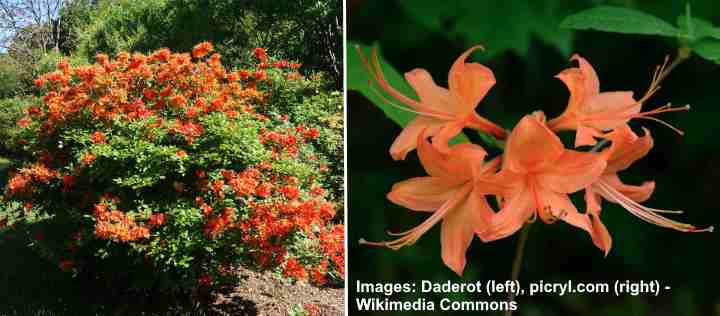
The flame azaela is a deciduous tree with a shrub-like growth habit. Perfect for front yard landscaping, the tree is characterized by its attractive, reddish-orange, star-shaped flowers. The tree has oval-shaped, mid-green leaves with a slightly hairy texture on both sides. In the fall, the leaves transition into spectacular colors of red or yellow, adding beauty to the autumn landscape.
The flame azaela grows best in well-drained, moist, acidic soils. Some landscaping ideas include planting as a privacy screen, flowering hedge, accent plant, or individual focal point. Reaching a height of 4 to 8 ft. (1.2 – 2.4 m), it is a great option for planting in small gardens. An interesting decorative feature is its buds, which resemble candle flames.
Mature Size: 4 to 8 ft. (1.2 – 2.4 m) tall and wide
USDA Hardiness Zones: 5 to 8
Sun: Partial shade or full sun
Waratah (Telopea speciosissima)
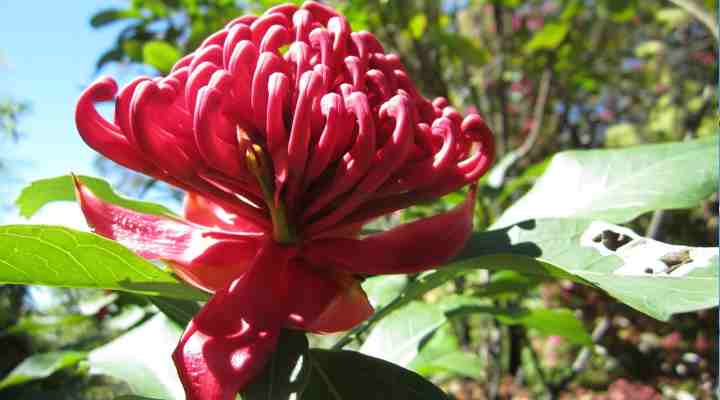
The waratah makes a stunning front of house landscaping addition due to its distinctive, vibrant, red flower heads. It also features sizable, leaf-like bracts that range in color from red, maroon, to pink, adding ornamental interest to the plant. Additionally, it showcases pointed, leathery, spoon-shaped leaves that are dark green in color.
The waratah tree should be planted in well-drained, slightly-acidic soil. With their stunning blooms and dense growth habit, these beautiful trees serve as great individual focal points or as solitary specimen trees. The flowers make excellent floral displays or cut flower arrangements.
Mature Size: 3 to 10 ft. (1 – 3 m) tall and wide
USDA Hardiness Zones: 8 to 10
Sun: Full sun to partial shade
Red Flowering Grevillea Trees

Red flowering grevilleas make excellent ornamental landscaping trees because of their cylinder-shaped clusters of eye-catching red flowers. These flowers have distinctive curled petals and prominent, curved stamens, and attract pollinators such as birds and bees. The tree also has slender, fern-like leaves that range in color from dark green to silver gray.
Grow red flowering grevilleas in well-drained soil. They are highly-versatile landscaping trees, can be grown as excellent hedges, screens, or specimen plants. In addition, these trees are low-maintenance and tolerant of drought conditions and deer once established.
Mature Size: 4 to 8 ft. (1.2 – 2.4 m) tall, depending on the species
USDA Hardiness Zones: 9 to 11
Sun: Full sun to partial shade
Common Lilac (Syringa vulgaris)
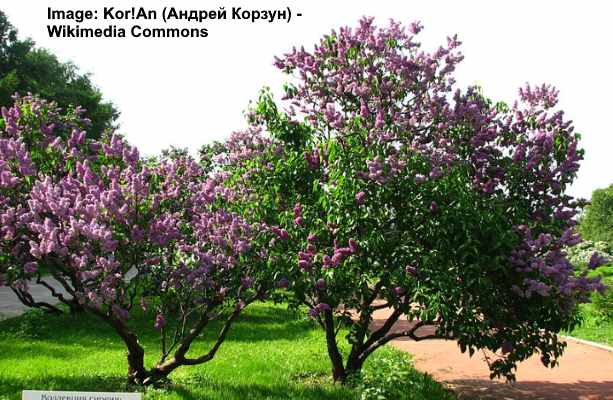
Lilac tree
With its attractive cone-shaped clusters of scentful, pinkish purple blooms, the lilac tree is excellent for landscaping your garden. Its small stature and attractive bushy form makes it perfect for planting in small yards. The leaves of this tree are smooth, heart-shaped and bluish-green to dark green in color.
The common lilac thrives in moist, well-drained soil in full sun. Its dense and appealing foliage makes it a great option for planting as a privacy screen or flowering hedge. With its scentful flowers that attract many pollinators, it is also excellent for planting in wildlife gardens.
Mature Size: 8 to 10 ft. (2.4 – 3 m) tall and 5 to 6 ft. (1.5 – 1.8 m) wide
USDA Hardiness Zones: 3 to 8
Sun: Full sun for best flowering
Angel’s Trumpet (Brugmansia suaveolens)
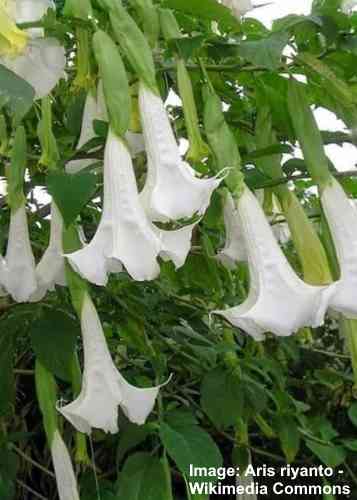
The angel’s trumpet is an excellent tree for landscaping your front yard due to its stunning, pendulous clusters of creamy-white, trumpet-shaped flowers. Some ornamental features include its dark-green, ovate, soft, alternate leaves covered in a thin layer of fine hairs and its dense, vase-like canopy with spreading branches.
The angel’s trumpet grows best in moist, well-drained, slightly-acidic soil. This versatile tree is sure to add an ornamental touch to any garden landscape. The tree is perfect for enhancing garden beds and borders, serving as a captivating focal point, accent plant, or specimen tree.
Mature Size: 3 to 8 ft. (1 – 2.4 m) tall and 2 to 4 ft. (0.6 – 1 m) wide
USDA Hardiness Zones: 9 to 11
Sun: Full sun or partial shade
Flowering Maple ‘Victor Reiter’ (Abutilon ‘Victor Reiter’)
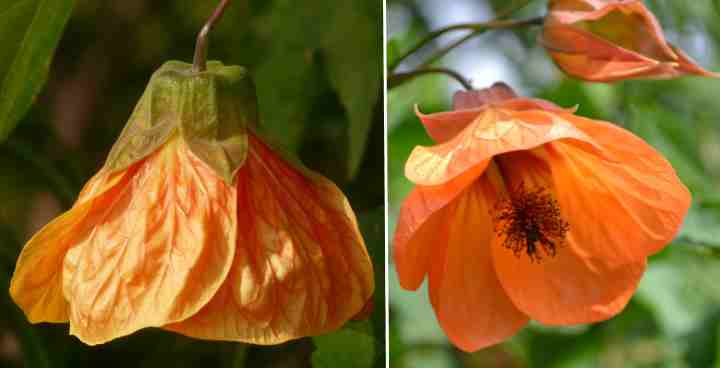
The flowering maple ‘Victor Reiter’ stands out as an excellent, decorative landscaping tree. It is known for its pale-orange, trumpet-shaped blooms. The flowers gracefully hang from the branches and have greenish-yellow centers, adding to the tree’s beauty. Additionally, the tree features maple-like, glossy dark-green leaves.
Make sure to grow the flowering maple ‘Victor Reiter’ in well-draining, moist soil. With their beautiful orange blossoms and compact size, they can serve as excellent landscaping trees in any garden. This tree is perfect for planting as an accent plant or specimen plant. It can also be trained to grow against a wall to provide visual interest.
Mature Size: 6 to 8 ft. (1.8 – 2.4 m) tall and 4 ft. (1.2 m) wide
USDA Hardiness Zones: 9 to 11
Sun: Full sun to partial shade
Small Evergreen Landscaping Trees
Adding small varieties of conifers such as spruce, pine, and fir trees can help complete the landscaping in a small-scale yard. Here are some of the best dwarf evergreen trees for landscaping a small garden.
Blues Weeping Colorado Spruce Tree (Picea pungens ‘The Blues’)
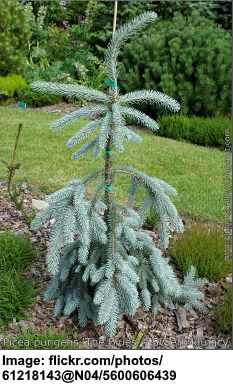
(blue weeping Colorado spruce tree) is a dwarf narrow tree which makes it an excellent choice for smaller landscapes or narrow spaces
The blues weeping Colorado spruce is an excellent choice for gardeners who want a small, evergreen landscaping tree. It is known for its eye-catching, steel-blue or blue-green needles that grow on drooping branches. Its compact size of around 6 ft. (1.8 m) makes it a great choice for enhancing small gardens or compact spaces. With its attractive foliage and year-round greenery, this small, ornamental tree makes an ideal centerpiece in any garden landscape.
Plant the blues weeping Colorado in moist, well-drained soils in full sunlight for optimal growth. This tree is tolerant of drought conditions, salt spray, and acidic soil. Other ornamental features include its cylindrical cones and columnar growth habit. It is perfect for adding a vertical accent to your garden.
Mature Size: Up to 6 ft. (1.8 m) tall and wide
USDA Hardiness Zones: 2 to 8
Sun: Full sun
Dwarf Japanese Black Pine (Pinus thunbergii ‘Kotobuki’)
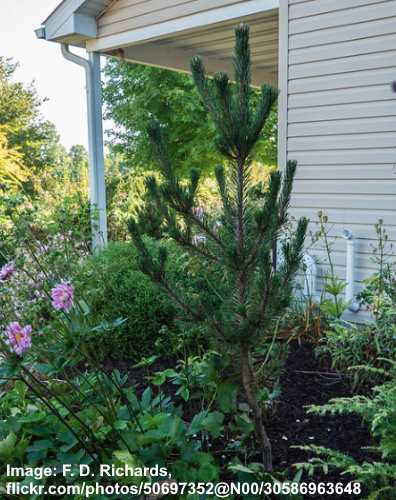
Dwarf Japanese Black Pine tree is suited to even the smallest garden and makes an excellent choice for the landscape
The dwarf Japanese black pine is ideal for adding a vertical element to small landscapes. This shrub-like, fast-growing evergreen tree is characterized by its dark green needle foliage, silvery-white candle-like buds, and brownish-gray cones. This tree adds interest to your garden with its irregular branching habit and upright, narrow form.
The dwarf Japanese black pine thrives in moist, well-drained soils. It makes a great accent tree, corner-of-house plant, or foundation plant. Once established, it is tolerant of drought conditions and salt spray, making it perfect for planting in arid or coastal landscapes. In addition, it can withstand cold conditions.
Mature Size: About 4 ft. (1.2 m)
USDA Hardiness Zones: 5 to 8
Sun: Full sun
Dwarf Pencil Point Juniper (Juniperus communis ‘Compressa’)

Dwarf pencil point juniper is a great tree for narrow spaces in your garden
The dwarf pencil point juniper is a small, upright, evergreen tree with a shrubby growth habit. Perfect in size for small landscapes, it is known for its attractive, prickly blue-green foliage and cone-shaped appearance. The leaves turn an attractive coppery color in the fall, adding beauty to the autumn landscape.
The dwarf pencil point juniper tolerates a wide range of soils, as long as they are well-drained. It is drought-tolerant once established. Some landscaping ideas include growing the tree as a vertical accent plant, foundation plant, or specimen plant. With its attractive evergreen foliage and beautiful canopy shape, this tree is sure to enhance your landscape.
Mature Size: Up to 5 ft. (1.5 m) tall and 1 ft. (0.3 m) wide
USDA Hardiness Zones: 2 to 6
Sun: Full sun
Dwarf Balsam Fir (Abies balsamea ‘Nana’)

The dwarf balsam fir is a compact, slow-growing conifer that is perfect for front-of-house landscaping. The tree produces flat, evergreen, needle-like leaves that are dark green in color. The leaves give off a wonderful pine aroma. Additionally, it has a horizontal branching structure and rounded canopy shape, adding to its appeal.
The dwarf balsam fir grows best in well-drained soil in full sun. It is a perfect accent or foundation plant. If you’ve got a balcony, porch, or deck, this compact dwarf tree can thrive just as well in containers. You can also plant it in rock gardens as a specimen plant.
Mature Size: Slowly reaches 2 ft. (60 cm) tall, 3 ft. (90 cm) wide.
USDA Hardiness Zones: 3 to 6
Sun: Full sun
Small Trees for Backyard Landscaping
When choosing the appropriate tree sizes for a small backyard, it’s important to consider maintenance as well. Opting for low-maintenance small trees like Japanese maples, crape myrtle trees, miniature magnolias, and dwarf junipers is a wise choice.
Certain types of fir trees also excel as privacy hedges in small gardens. They demand minimal maintenance and boast soft, dense foliage.
Small Trees for Front Yard Landscaping
Some of the most popular low-maintenance small trees for the front yard are small cultivars of redbuds, crabapples, dogwoods, and magnolias. In a small front yard, these flowering trees will also create a stunning impact on the look of your home.
Related articles:

